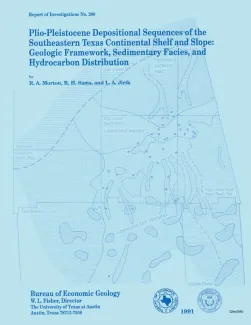
Publication Details
Geolocation:
Get the Publication
$9.00
Abstract/Description:
Plio-Pleistocene strata of offshore Texas having hydrocarbon exploration potential are restricted to the southeastern continental shelf and upper continental slope. This thick wedge of nearshore and deep-marine sediments firms the west margin of a late Neogene and Quaternary depocenter. The wedge is divided into eight genetic sequences on the basis of well logs, paleontological reports, and seismic profiles. These same data are also used to establish the structural framework, determine the timing of deformation, and map the principal depositional systems of the western Gulf Coast Basin during the past 3m.y. Contemporaneous sea-level fluctuations, salt migration, and shifting sites of sedimentation caused substantial lateral variations in sedimentary facies as well as structural styles. The resulting complex geologic history of this part of the basin directly controlled the migration and entrapment of hydrocarbons.Early Pliocene inundation of the continental platform and attendant deposition of marine mudstones was interrupted by a fall in sea level and development of a broad entrenched system landward of the shelf margin. Repeated excavation of the entrenched system during the middle and late Pliocene promoted the deposition of successive sand-rich submarine channels and fans. These lowstand deposits extended more than 100 mi (160 km) basinward of the paleomargin. Overlying Pleistocene sediments were deposited mainly by mud-rich fluvial-deltaic systems of moderate size. These rivers and shelf-edge deltas constructed a broad continental platform that buried the submarine fans and prograded the shelf margin tens of miles basinward. Sand-rich delta-front deposits were faulted and slumped along unstable shelf margins and were resedimented on the continental slope. As a result, the Pleistocene sandstones were trapped by growth faults and in withdrawal synclines and therefore are not present very far downslope of the extant shelf margin.Plio-Pleistocene reservoirs contain an estimated 1.5 billion barrels of oil equivalent in at least 75 different fields. The fields are located near diapirs or faults associated with late salt movement. Structural style, reservoir facies, and hydrocarbon composition are used to group the fields into six exploration plays. The most prolific play encompasses stacked sandstone reservoirs and broad rollover anticlines located between the Trimosina regional and counterregional fault systems. Each play produces gas and some oil; however, most of the oil comes from the oldest lowstand submarine fans (Globoquadrina altispira and Lenticulina 1). All six plays offer some potential for either new field discoveries or reserve growth.